Matador Network's Blog, page 466
June 8, 2022
The Best Beach Tent for Babies You’ll Use All Summer Long

We hope you love the beach tent we recommend! Just so you know, Matador may collect a small commission from the links on this page if you purchase.
Like many people who live in the great (and unfairly maligned) state of New Jersey, I am a beach person. I spend a few weeks out of the summer on the beach, baking in the sun, and taking the occasional break to stroll down the boardwalk with a soft-serve cone in one hand and a basket of cheese fries in the other.
Very recently, I became a beach person who is also a mother. My daughter is nine months old, still sensitive, fragile, and new to the world. Despite these qualities, which necessitate being cautious about where her father and I take her, I knew that I couldn’t give up my summer weekends on the beach. I just needed to figure out a way for her to hang out on the beach with me safely — protected from the scratchy sand and the sun’s harsh rays. Thankfully, I discovered the best beach tent for babies, which turned out to be absolutely essential.
A little background first: In case you weren’t aware, The Jersey Shore (although thanks to a certain pop culture phenomenon, you probably already are; thanks Snooki!) is home to some of the best beaches in, well, the world, if I can toot my state’s horn for a second. And they are almost all, across the board, extremely family-friendly. For out-of-towners looking for an affordable beach vacation for their family, and locals alike, the Jersey Shore is a great destination.

Photo: Elisabeth Sherman
That being said, if you have young kids, taking them to the beach is risky. When they are my daughter’s age, babies tend to sit around, happy to be held or to play with their toys for a few hours — but there are dangers involved. Even if you slather your baby in sunscreen (which I do), young ones are susceptible to sunburn, and for them, it is extra painful and uncomfortable. And if they accidentally grab a handful of sand and push it into their eyes? Game over. Your day at the beach is done — and not only that, you’re likely to spend the rest of the day washing sand out of a wailing, fidgeting baby’s eyeballs.
That’s why it doesn’t work to simply throw a beach towel in your bag and plop your baby (especially if they are under one) on it under a rented umbrella and hope for the best. A tent is a great option—and trust me when I say that I have seen families bring actual camping tents down to the beach and set up their kids inside them. But there is also some gear that was created for this exact purpose, and the best beach tent for babies that I’ve found is the Babymoov Aquani Tent & Pool. This tent folds up easily into a carrier, is light enough to carry down to the beach without being a hassle, and it’s a pop-up tent, meaning you don’t have to assemble it once you’re on the beach. It even comes with stakes so you can anchor it to the sand so you don’t have to worry about it blowing away.

Photo: Elisabeth Sherman
The best beach tent for babies needs to pass a couple of other inspection points: First of all, even if you rented or brought your own umbrella to the beach, your tent needs to have its own canopy or shade of some kind for an extra barrier against the sun. It also needs sides. This is crucial. It can’t be flat because babies — notoriously curious but incautious creatures — need a barrier between them and the sand. Left to their own devices, babies will grab, touch, smush, and scoop the sand all over their faces and bodies, and then you’ve got problems. And even a slight gust of wind — common on the beach — can blow sand into their eyes and mouth.
The Babymoov tent hits all these essential points. And it gets even better! There’s a thick, soft mattress insert, which offers a soft surface for your babe to sit on comfortably for hours at a time. However, if you remove it, the bottom of the tent transforms into a water-safe wading pool.
This feature is important for a couple of reasons: Young babies aren’t quite ready to hit the surf yet, but if you’re a beach person, you probably want to get them used to ocean water so that one day they’ll be able to play in the waves without getting scared. Dumping a couple of bucket fulls of ocean water in the tent or pool is a smart, effective way to get your baby acclimated to the feel and the temperature of ocean water—and near to mom and dad, they’ll feel safe enough to splash happily in the water. Oh, and here’s another big plus: sitting in cool water for a few minutes will help your baby cool down on hot days.
The other great thing about the Babymoov tent is that, as I mentioned, it includes its own detachable canopy. I leave it on when we’re at the beach, but I take it off when we’re in the backyard at our house, where the sun isn’t as extreme and she’s comfortable in the shade. However, the canopy also includes a length of netting, which can be pulled back from the canopy or stretched forward to encompass the entire tent, protecting your baby from bugs and wind. This extra barrier from the elements might just be for the parents’ peace of mind, but when it comes to protecting your baby from inclement weather, there’s no way to really go overboard.
Finally, this tent is roomy. I dumped her favorite toys in the tent and my daughter played peacefully for at least four hours, which gave me a much-needed break from baby duty all while I was assured that she was safe from sand and sun. And guess what? I know it worked because she didn’t get a sunburn. And when we took her home to rinse her off in the sink at our beach house—and I’m not exaggerating when I say this—I didn’t see any sand flow into the drain, which feels a little miraculous. All these elements combined make it the best beach tent for babies.
Beach people, hear me: This tent is safe! It protects your baby from sunburn. It doesn’t let the sand in. It gives them enough room to play without feeling confined. You’ll be able to relax on the beach (what else is the beach for?), knowing that your baby is having a good time too. And really, that’s all the beach is about. Have a good time, no matter how old you are. 
We hope you love the beach essentials we recommend! Just so you know, Matador may collect a small commission from the links on this page if you decide to book a stay. The listed prices are accurate as of the time of publication.
More like thisTechnology + GearEverything You Need for a Trip To the Beach This Summer11 Fredericksburg Airbnbs To Experience the Best of Texas Hill Country

Fredericksburg, Texas, gives you the best of Hill Country’s wineries, boutiques, and outdoor pursuits. Opt to stay downtown among the German heritage buildings and restaurants or whisk yourself away to a remote ranch or cabin. Unique Fredericksburg vacation homes include farm stays, treehouses, and more. We’ve rounded up the best Airbnb Fredericksburg TX rentals to save you the hassle.
Unique Airbnb Fredericksburg Treehouses and CabinsAirbnb Fredericksburg rentals with a poolWe hope you love the Airbnb Fredericksburg stays we recommend! Just so you know, Matador may collect a small commission from the links on this page if you decide to book a stay. Listed prices are accurate as of the time of publication.
Unique Airbnb Fredericksburg Treehouses and CabinsModern A-frame cabin in nature
Photo: Airbnb

Photo: Airbnb

Photo: Airbnb
A convenient 10-minute drive from the attractions and amenities of Main Street, this swanky chalet makes it easy to strike a balance between exploring and getting your share of downtime. The cabin consists of two bedrooms, a bathroom, a well-stocked kitchen, and a lounge with views. Connect with nature from the heated stock tank pool and spend long nights under the stars with s’mores around the fire.
Five guests, two bedrooms
Price: $375 per night

Photo: Airbnb

Photo: Airbnb

Photo: Airbnb

Photo: Airbnb
This unique Airbnb Fredericksburg TX treehouse is a dream come true for couples. Whimsically decorated with delicate fabrics and kitsch details such as a vinyl turntable with a Bluetooth speaker, the rental marries convenience with romance. The upper deck is fitted with a hammock while the outdoor hot tub overlooks the surrounding nature from a different perspective. Remember to pack a book and a deck of cards to enjoy from the book nook.
Two guests, one bedroom
Price: $495 per night

Photo: Airbnb

Photo: Airbnb

Photo: Airbnb

Photo: Airbnb
This peaceful Airbnb Fredericksburg cottage is centrally located yet offers the solitude of a remote getaway. The farmhouse has been beautifully converted to resemble a boutique hotel with chic contemporary fixtures and thoughtful touches including fireplaces. A private patio is fitted with an outdoor TV, fire, and hot tub that offer an eyeful of the fields. This one is a haven for honeymooners and special anniversaries.
Two guests, one bedroom
Price: $455 per night
Traveling to Texas? Check out Matador’s Texas accommodations guides:The best Texas Airbnbs to experience Lone Star cultureThe best Dallas Airbnbs, from a Deep Ellum warehouse to a family ranch9 San Antonio Airbnbs within walking distance of the riverwalkThe 9 most exciting boutique hotels in DallasThese 9 luxurious Houston Airbnbs are the best in the heart of the cityThe best Austin Airbnbs for large groupsEnchanted tree house with cedar tub

Photo: Airbnb

Photo: Airbnb

Photo: Airbnb

Photo: Airbnb
Nestled among the oak trees a short drive from Main Street, this Fredericksburg Airbnb treehouse is one of eight bespoke rental plots in a sublime patch of forest. This treehouse consists of a double bed, a bathroom, and a kitchenette. The space includes a private deck with a cedar soaking tub that peers over the woodlands. Communal amenities include swings, an outdoor heated pool, a sauna, and a fire pit.
Two guests, one bedroom
Price: $760 per night

Photo: Airbnb

Photo: Airbnb

Photo: Airbnb

Photo: Airbnb
Sited a 10-minute drive from Main Street, this brand new A-frame chalet is perfect for groups seeking an all-round experience of downtown, hiking, and wineries. This family-friendly Airbnb Fredericksburg vacation home comprises two double bedrooms and two twins as well as a full kitchen and bathroom. Besides the private spa tub on the deck, you’ll appreciate access to the shared sauna.
Nine guests, four bedrooms
Price: $475 per night

Photo: Airbnb

Photo: Airbnb

Photo: Airbnb

Photo: Airbnb
Situated on the bank of Barons Creek, this restored 1895 German rock and log homestead offers outstanding views from the dock. Swimming isn’t permitted but the life-size Connect 4, shuffleboard, arcade zone, and other games more than make up for that. Interiors are cozily appointed with an old-fashioned freestanding bathtub for that much-needed R&R. Bursting with personality, this fun Fredericksburg Airbnb suits sociable – and playful – groups and families.
Six guests, two bedrooms
Price: $280 per night

Photo: Airbnb

Photo: Airbnb

Photo: Airbnb

Photo: Airbnb
The Ginger Ranch is set upon 65 acres a mere 10-minute drive from downtown Fredericksburg and consists of a farmhouse plus five individual cabins. The main house contains a full kitchen and lounge. Those sleeping in the cabins will share an external bathhouse that comes with an al fresco vintage tub. Amenities include a private swimming pool, hot tub, games barn, playground, and fire pit. This one-of-a-kind ranch Airbnb Fredericksburg is available for weddings.
Sixteen guests, seven bedrooms
Price: $1,395 per night

Photo: Airbnb

Photo: Airbnb

Photo: Airbnb

Photo: Airbnb
Luxury meets history at this 1848 ranch, reimagined for the modern traveler with state-of-the-art appliances and fixtures. The backyard features a swimming pool (heated on demand), hot tub, and fire pit. Views stretch for miles over the farm fields and you can expect to spot local livestock roaming around your plot as you soak up the environment. Situated a 10-minute drive from downtown Fredericksburg.
Fifteen guests, five bedrooms
Price: $1,405 per night

Photo: Airbnb

Photo: Airbnb

Photo: Airbnb

Photo: Airbnb
This luxurious downtown Fredericksburg TX Airbnb with a pool benefits from an expansive sun terrace and a covered dining zone. A mini golf course provides endless entertainment and the chance to sharpen your swing. Interiors are neatly stylized with quality linens and attractive pieces of art. With heaps of space inside and out, this is a top choice for families and groups alike.
Ten guests, four bedrooms
Price: $820 per night

Photo: Airbnb

Photo: Airbnb

Photo: Airbnb

Photo: Airbnb
Slap bang in the heart of downtown, this Fredericksburg Airbnb near Main Street will suit those hungry to explore the local restaurants and sights. Originally a 19th-century German stone home, the property has undergone major expansion and modernization to transform it into a deluxe vacation rental. A fenced backyard comes with a pool, fire pit, and covered dining area.
Fourteen guests, six bedrooms
Price: $780 per night

Photo: Airbnb

Photo: Airbnb

Photo: Airbnb

Photo: Airbnb
This bohemian-themed spacious Fredericksburg Airbnb family vacation home is handy for downtown as well as the regional wineries. The open concept property revolves around a back patio complete with a pool, hot tub, and cornhole boards. An elegant kitchen is a joy to prepare meals in that can be enjoyed from the external dining area. Bedroom suites follow a monochrome style with fetching paintwork and oversized showers in the attached bathrooms. Help yourselves to fresh eggs from the coop. 
Twelve guests, four bedrooms
Price: $460 per night
Every Day Is World Ocean Day at These 8 Overwater Bungalows With See-Through Floors

Sure, overwater bungalows are great (bucket-list great). And it’s amazing to be able to jump out of bed and into the ocean in less than 10 seconds.
But what’s even more incredible than overwater bungalows are overwater bungalows with see-through floors, which allow you to watch the ocean even when you’re not in it. All the hotels below feature overwater bungalows, plus sections of the floor that are entirely see-through. And in the case of some overwater bungalows, the see-through areas are in the bathrooms, so you can watch ocean life swim by while brushing your teeth. Nice.
The best way to develop a love of the ocean is to learn about the beautiful and otherworldly creatures in it. Ocean health is a harbinger of planet health, and the effects of global warming, overfishing, and pollution and starting to take their toll on the planet’s underwater world. That’s why June 8 was designated as “World Oceans Day” by the United Nations and various international environmental organizations. So while you’re admiring the mesmerizing underwater world from within your overwater bungalow, be sure to also think about some of the very tiny changes you can make to ensure the cute little marine critters you see have a clean home for centuries to come.
Maldives overwater bungalows with clear floorsIt shouldn’t come as a surprise that an island as associated with perfect ocean views as Maldives has more than a few ideal places to celebrate World Oceans Day every day.
Robinson Club Noonu
Photo: Suzie Dundas
There are two Robinson Clubs in Maldives, both of which offer a host of activities ranging from sunset beach bars to dance parties to snorkeling and Zumba classes. But when you see the view from the bathroom of your overwater bungalow at Robinson Club Noonu, you may decide to stay inside all day. The resort’s rooms over the ocean have huge decks and private pools, as well as super-cool mesh hammocks built into the floor next to the bathtubs. So while you wait for your bath to heat up, you can hang out (literally) just a few feet above the ocean. The tiny, harmless sharks that hang out below the bungalows are particularly cute.
Lilly Beach Resort
Photo: Lilly Beach Maldives
Lilly Beach Resort‘s Deluxe Water Villa impresses as soon as you enter through the front door, thanks to a six-foot-long clear floor panel in the entryway. In addition to the glass panel long enough for the average human to lay on, the deluxe rooms also have huge bathroom that opens to the Indian Ocean, giant over-the-water decks, and private plunge pools. And resort guests have access to a plethora of activities ranging from private hammock rafts to nighttime tours on a semi-submerged submarine hanging just a few feet below the surface.
Soneva Jani
Photo:
There’s no need to book the most expensive overwater bungalow at Soneva Jani, a resort founded on conscious travel and sustainable tourism. Nearly all of the overwater bungalows at the high-end resort have clear paneled segments on the floors looking down into the shallow lagoon.
But one of the coolest see-through floors may be in the resort’s one-bedroom reserve villa, which has a round panel directly beneath the dining table (try not to feel weird if you ordered the fish). Sure, most guests probably book the villa for its two-story waterslide, but having your morning coffee while sitting on the glass panel is the stuff World Ocean Day dreams (and Instagram posts) are made of.
Sun Siam Iru Fushi
Photo: Sun Siyam Iru Fushi
With 15 restaurants and bars, it’s surprising that prices at Sun Siam Iru Fushi start in the vaguely reasonable low $300s in the summer. It’s even better that all their water villas have glass-bottomed floor panels. Depending on which villa you pick, yours may be next to the couch or on one side of the bed — you’ll have to flip a coin for who gets the side next to the fish.
W Maldives
Photo: W Maldives
Who wouldn’t want to book a room called the “Extreme WOW Ocean Haven?” The two-room overwater bungalow at the well-known W Maldives has two long see-through panels in the living area, though the views from the large infinity pool, glass sliding doors, and huge outdoor couch are pretty “extreme wow,” too.
Don’t want to spring for that room? Don’t worry. Most of the villas have a glass floor segment and the hotel’s SIP bar and lounge has cozy outdoor couches suspended on a boardwalk over the lagoon.
Hotel Kia Ora, French Polynesia
Photo: Hotel Kia Ora
On Rangiroa — a very small (and very gorgeous) island in French Polynesia popular with scuba divers — the underwater world is the main draw. Fortunately, you don’t need to be a diver to peek at the underwater world if you stay at Hotel Kia Ora. In fact, you don’t even need to stay there to see the guests of honor on World Ocean Day. Just pop over to the hotel’s Miki Miki Bar, suspended over the turquoise lagoon. The open-air bar has several clear floor panels scattered around the bar area, ensuring everyone gets a peek at the fish and tiny sharks known to frequent the area.
Lina Point Belize Overwater Resort, Belize
Photo: Lina Point
Lina Point is spot-on when they describe their rooms as being built over an aquarium. While the overwater bungalows leave no shortage of places to watch the ocean, one of the coolest spots — especially for kids — will be from the see-through floor panels, which are standard in all the rooms. Many rooms also have rope hammocks suspended over the ocean and swings perched on the edge of the over-water decks. If you want to celebrate World Ocean Day every day, you’ll be glad to know overwater bungalows start at just $300. It’s a great hotel for adventure travelers or anyone planning to visit Ambergris Caye’s nearby Blue Hole.
Sunlight Ecotourism Island Resort, Philippines
Photo: Sunlight Hotels and Resorts
The Philippines may not be the first place that comes to mind when you envision overwater bungalows, but the luxurious Sunlight Ecotourism Island Resort has some of the best views of the underwater world you can get without getting wet. The hotel’s Sirakin Villas have not just glass panels but full-on glass floors. Try not to trip if you have a few drinks and forget about the unique feature when you walk back into your villa.  .
.
More like thisEpic StaysIt’s Time To Check Overwater Bungalow Off Your Bucket List
5 Things You Can Do in 5 Minutes To Help the Planet on World Ocean Day

June 8 is World Ocean Day, an opportunity for everyone to pause and appreciate the oceans that cover two-thirds of our planet — and maybe get out for a morning surf or swim.
It’s also the perfect time to take a moment to help the oceans that keep our global ecosystem functioning. World Ocean Day was first recognized by the United Nations General Assembly in 2008, and a non-profit operating under the same name is the steward of the annual awareness day. The latter works with global partners to support conservation efforts to protect the world’s oceans and underwater flora and fauna.
Fortunately, taking action to help the oceans doesn’t have to be a time-intensive activity. Here are five things you can do in five minutes or less to help the world’s oceans today (and every day).
Add your name to the 30×30 initiativeThis is The Climate Win, the most positive sustainability news around the world.

Photo: V_E/Shutterstock
The idea to protect 30 percent of Earth’s land and water by 2030 has been dubbed the 30×30 Initiative. Political and social leaders in countries from around the world, including the United States, are united in an effort to make this happen. Protecting 30 percent of the world’s oceans will help to ensure healthy sealife populations, maintain carbon sinks, and give the oceans the power they need to stabilize the global ecosystem. All you have to do to show support is sign this quick letter to your political representatives (pre-written and ready to send).
Matador spoke with New Mexico Senator Tom Udall about the 30×30 initiative and why it’s so important.
Use reef-safe sunscreen
Photo: Badger Balm
One of the easiest ways to help protect the oceans is to experience and enjoy them for yourself. It’s impossible to understand why something is so important to protect if you haven’t seen how incredible it is firsthand. Just be sure to use reef-safe sunscreen. This means sunscreens that are free of oxybenzone, avobenzone, octisalate, octocrylene, homosalate, and octinoxate. Don’t worry – there’s no need to memorize that list. Matador has a complete rundown of reef-safe sunscreens ready to go.
Buy a new pair of kicks that kick back to the ocean
Photo: SeaVees
World Ocean Day is also a great time to re-up your sneakers for the summer. SeaVees, the eco-conscious shoe company that donates $1 per pair of shoes sold towards restoring ocean health, has stepped its impact up about five notches. The brand’s new SeaChange collection is designed to have no impact on the ocean. Your shoe is made from pineapple yarn, corn leather, or recycled cotton canvas, depending on the model. Laces are made of post-consumer recycled plastic, liners of recycled cotton, and outsoles with natural and recycled rubber.
The result is a comfortable, casual kick clean enough for a night out yet perfectly casual. And yes, your purchase still commits $1 to coastal restoration efforts. Buying a pair is a great way to show the fashion industry that eco-friendly products are in demand and worth the effort to consumers.
Try a kelp burger
Photo: Akua
Animal agriculture is responsible for 14.5 percent of global emissions, according to Climate Nexus. Simply put, raising animals for meat uses a lot of resources and produces a lot of emissions, so the best way to prevent those emissions is to eat less meat. It’s easier to do this now than at any time in recent memory, thanks to new meat-free protein options.
One such option is the kelp burger — yes, it’s made of seaweed, and no, it doesn’t taste “fishy.” Companies such as Akua are leading the charge to create sustainably farmed kelp that actually creates new carbon sinks in the ocean through the farming process. Matador spoke with Courtney Boyd-Myers, founder of Akua, about how her brand is farming kelp in the northeastern United States and creating carbon sinks along the way.
Check the label when eating seafood
Photo: Ihi/Shutterstock
Among the biggest threats to ocean health and biodiversity is overfishing. Healthy fish populations are essential to a balanced ocean ecosystem, with each species playing a role in the natural order. Large-scale fishing operations often have a devastating impact on populations of specific fish, disrupting local ecosystems and throwing the natural balance out of whack.
If you choose to eat seafood, look for Marine Stewardship Council (MSC) and Aquaculture Stewardship Council (ASC) labels to ensure the meal you are about to eat was sourced responsibly. When possible, eat seafood near its source from restaurants and markets that support local purveyors. Bookmark this website from the Monterey Bay Aquarium’s Seafood Watch program to check on-the-go if the fish you’re ordering or buying is sustainably harvested. 
10 Reasons Marseille Is the Most Underrated French City

Considered the black sheep of the Cote d’Azur, Marseille has long been passed over in favor of its glossy cousins — but since its stint as European City of Culture in 2013, the city has firmly owned its cultural crown. It wouldn’t be a stretch to proclaim that right now, Marseille is the best French city to visit for food, stunning beaches, culture, art, and architecture.
I’ve lived in and traveled around France for four years, but it’s Marseille I return to time and time again. What draws me back isn’t the gleaming new waterfront or its upscale restaurants — it’s the mixture of grit and glamour; the patchwork of traditions old and new, French and North African, rough and cool. Marseille is a sunny, sultry melting pot, encircled by mountains yet open to the world.
There’s a palpable buzz about the city, and it’s not something that’s been concocted for tourists. You’ll find all the culture, food, and art you crave here — but without the crowds and sky-high prices of Paris, or the dull menus that plague France’s smaller cities.
Diverse, exciting, and with a proud population that’ll welcome you into their home — here are 10 reasons why it’s the most underrated city in France.
You can have the best of both worlds
Photo: Gaspar Janos/Shutterstock
City break or nature break — the eternal quandary. With a visit to Marseille, you can have the best of both. Calanques National Park presses up against the city’s south side, which means all within the space of a short bus ride (or walk, depending on where you’re staying), you can find yourself hiking through Mediterranean coast paths with not a car in sight.

Photo: Gaspar Janos/Shutterstock
Here, fragrant pine-flanked footpaths take you right down to the ocean’s edge where you can enjoy the beach, have a swim, or kayak. Once you’ve recharged your batteries, reverse the process and head back into the bright lights of Marseille for cocktails and a slice of pizza by the port. Speaking of pizza…
It’s France’s pizza capital
Photo: Chez Sauveur
Pizza is found all over France, but Marseille does it best. It’s a dish rooted in local history: in the 1900s, residents of Naples fled the poverty of their city, with many emigrating here with their recipes. True to Marseille’s multicultural spirit, you’ll find French and North African takes on the traditional Italian version. Look out for local cheeses and merguez sausage — a cumin and chili-spiced dish from Algeria.
If you’re short of time it’ll take a leap of faith to serve Bouillabaisse — a dish for which the city is known — but trust me. The latter is considered tourist food; it’ll set you back about 50 euros per person minimum, and mediocrity reigns.
Pizza is truly the food of the locals, served hot and fresh, with crisp dough topped with tomato sauce and real Italian cheese. And in a country where dining errs towards the formal, the convivial aspect of grabbing a slice and eating it off a paper plate adds to the fun.

Photo: Chez Sauveur
Check out Chez Pizzas Charly (not to be confused with Charly Pizza – more on this one later) for a slice-to-go, or book a table at Chez Sauveur for views over the Vallon des Auffes harbour.
It’s home to some of the best beaches in France
Photo: Patchanokk/Shutterstock
Marseille has city beaches that can easily compete with the white sandy beauties at Cannes and Nice — but what you’re really here for are the Calanques (a word that means ‘cove’ in French). The rocky inlets and cliffs south of Marseille offer picture-perfect views: jagged limestone cliffs meet crystal clear waters and not a high-rise in sight.

Photo: Office Métropolitain de Tourisme et des Congrès de Marseille
En Vau is the most dramatic of the coves. To get there, park in Cassis (a short drive from Marseille), then follow the marked footpath down to the shingle beach. The climb is steep both up and down, so wear good shoes, be prepared to slip, and bring water. The little cove also gets crowded in the afternoon when it’s flooded with sun (the high cliffs mean it’s blanketed in shade come late afternoon — good news for those with a tendency to burn) — so come early if you want a sunny spot.
For a dip in the med with less effort, Somiou is both easily accessible (including for people with mobility needs) and stunning. Park on one of the residential roads near the park entrance and walk down — or book a spot at the beachside restaurant to use the car park right next to the beach. Alternatively, boat trips leave Vieux-Port, and Cassis, every day. Check before visiting to make sure the park is open — summer wildfires happen on occasion, and when risk is high, the park shuts (though you can still visit beaches by boat).
The Arabic, French, and Brutalist architecture
Photo: Vincent Ducheman/Shutterstock
When people think of France, it’s usually Paris’ leafy boulevards and grand 19th Century terraces that spring to mind — or else Provence’s stone farmhouses with shuttered windows. Marseille offers something a little different. A crossroads of immigration since its founding by the Greeks circa 600 B.C., you’ll find Greek and Roman ruins here, Arabic architecture, 19th Century boulevards and buildings — The Cathedral of Sainte-Marie-Majeure is a must-visit — plus Brutalist creations thrown into the mix.

Photo: Office Métropolitain de Tourisme et des Congrès de Marseille
In fact, Brutalism (an architectural style characterized by a blocky look and constructed by poured concrete) was pioneered by the French architect Le Corbusier, and you’ll find the best example of his work — The Cité Radieuse — right here in Marseille. An answer to the social housing problems of the time, it proved such a success that it was replicated around the world. The building runs tours every day in French and English (although you can visit the roof at any time) — check out the website for up-to-date listings.
It’s street art
Photo: Office Métropolitain de Tourisme et des Congrès de Marseille
Marseille is the unofficial capital of lots of things: pizza, bouillabaisse, pastis, and pétanque — but it’s also home to some of France’s best street art.

Photo: Office Métropolitain de Tourisme et des Congrès de Marseille
Despite a glitzy facelift along the waterfront, the city remains stubbornly bohemian, with gritter neighborhoods a stone’s throw from more modern developments. Two of these are known for their art: the Panier district, which is the little network of narrow streets behind the cathedral; and Cours Julien (or “Cours Ju” as it’s known to the locals), a trendy neighborhood where residents sip organic lemonade with their sourdough toasties at outdoor cafes. Here, walls, steps, doorways, and windows are splashed in color. Look out for France’s iconic Monsieur Chat, plus little mosaic creations created by Invader — one of France’s most famed street artists — and the bulging-eyed creations of Brazilian artist Nhobi.
MauMA, the Museum of Urban Arts in Marseille currently has an open call for street artists to come and set something down in the city’s harbor area between 2022-2026 — meaning Marseille’s street art credentials will only continue to grow over the next few years.
Its forts and islands

Photo: S-F/Shutterstock
The entrance to Vieux Port comes with not one, but two historic forts. Built in the 17th century and restored in the 19th, Fort Saint-Nicholas offers scenic views over the port and the dramatic Mediterranean coastline beyond the harbor. Directly across from it, you’ll find Fort St-Jean, which is now part of the MuCEM complex, which opened in 2013 as part of Marseille’s year as European Captial of Culture. Offering similarly stunning views over the port and Med, this spot comes with pretty landscaped gardens — perfect for taking a breather from the sultry midday sun.

Photo: Boris Stroujko/Shutterstock
Delving deeper into Marseille’s military history, The castle of d’If — the first royal fortress of Marseille — is visitable by boat and offers incredible panoramas, while Ratonneau island and Pomègues offer beaches and historic sights.
Exhibitions at Friche la Belle de Mai
Photo: Friche la Belle de Mai/Caroline Dutrey
Marseille’s cultural game is strong, with a bevy of museums, concerts, and exhibitions to choose from. Friche la Belle de Mai leads the way in the alternative arts scene. This former tobacco factory — which became part of an urban regeneration project — sits in one of the city’s poorest neighborhoods, right behind the Saint Charles train station.

Photo: Friche la Belle de Mai/JC Lett
Here, you’ll find free outdoor cinema screenings, farmers markets, art exhibitions, a skate park, and an array of music concerts putting on everything from dance to jazz. In the summer, visitors head up to the rooftop for live performances and well-priced dishes made with fresh local ingredients.
Cocktails and music in France’s largest port

Photo: Dmitry Rukhlenko/Shutterstock
I’d say ‘don’t miss the port’ but it’s impossible: Marseille’s historic Vieux Port is the biggest in France, and sits right in the heart of the city. It has its fair share of yachts, but overall feels far more lived in than the glossy harbors in Nice and Cannes — expect to see fishing boats come and go and smell petrol in the air. The pavements around the port are stained with years of boat oil and the boot scuffs, and on summer evenings, you’ll find street musicians, children kicking footballs around, and couples sitting on the dock tucking into — you guessed it — pizza. While the touristy restaurants around don’t offer much for the discerning diner, they’re good for a sunset aperitif before dinner elsewhere.
Marseille’s food markets

Photo: Artens/Shutterstock
Make your way over to the Port Vieux Pavilion (designed by Norman Foster for the architect buffs out there) for 8:30 AM to catch the fishing boats rolling in and fishermen unload their flip-flopping cargo onto iced stands. Giant swordfish, glistening octopus, and red crabs make an enticing sight whether you intend to buy or not — just don’t get in the way of the locals choosing their pick of the catch.

Photo: Francesco Bonino/Shutterstock
After you’ve taken in the aquatic offerings, head to Noailles, one of the city’s oldest immigrant quarters. Here, Moroccan spice marts sit alongside fragrant Lebanese bakeries and bric-a-brac shops selling loofahs. For a lunchtime snack, join the queue at the Marché des Capucins for cheap slices of fresh anchovy pizza at Charly, or head across the square to Poissonnerie du Lamparo for a paper cone filled with fried sardines.
It has the best city views
Photo: Office Métropolitain de Tourisme et des Congrès de Marseille
Nestled slap bang between the glittering Med and rocky mountains, Marseille really has it all when it comes to views. Arriving by train gives you a real wow moment: step out of the station and onto the monumental Saint Charles station steps, which lead you down into a maze of streets and the city’s massive port. For sensational afternoon views with a cooling breeze, head up to the Saint-Jean Fort gardens and grab a deckchair in the shade.

Photo: Mariya Golovianko/Shutterstock
For prime sunset seats, you’re spoiled for choice, with plenty of hotels and restaurants opening their terraces to those after a cool drink. Le Rooftop offers harbor views and heaps of space, while Rowing Club Marseille offers a more romantic option — a leafy terrace with boats bobbing below. For smaller crowds and cheaper tipples, head to the terraces of Place de Lenche in the Panier quarter. Le Barjac serves mojitos for five euros, while shots of Ricard are still only two euros. 
The 9 Most Underrated Beaches in Florida
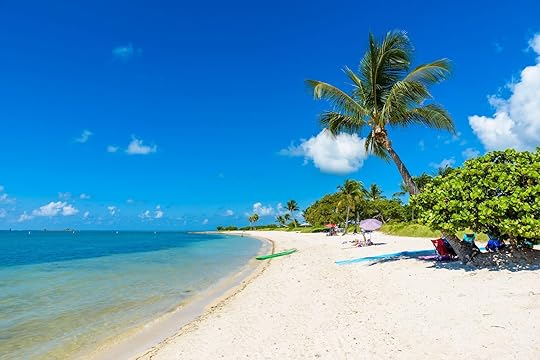
I’ve lived in Florida for a long time. How long? So long I remember when drug dealers used cool stuff like speedboats and Ferraris, rather than highly combustible mobile homes. I remember when people had the decency to hide their grim reaper tattoos somewhere other than their face. Ah yes, Old Florida was a helluva place.
But having been here so long, I’ve gained a lot of knowledge in stuff much nicer than exploding meth labs and face tats. I’ve also spent enough time on our world-famous beaches that my skin is roughly the consistency of a football. Ok, not really, but I have seen the best our 825 miles of beaches have to offer from the Panhandle to the Keys while traveling the state both for work and leisure. This has led me to some fantastic stretches of sand, many of which are overlooked by the vacationing masses. So if you’re planning a trip down, these are the best Florida beaches I’ve found that the crowds haven’t yet invaded.
Near Panama City: Grayton Beach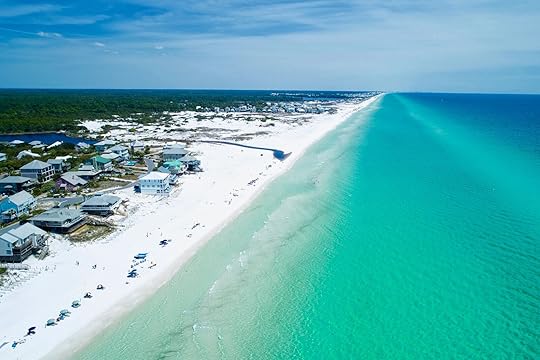
Photo: Rotorhead 30A Productions/Shutterstock
Tucked between Ft. Walton and Panama City, Grayton Beach is a little chunk of small town America that’s carved out of Cypress trees along the Florida Panhandle. The beach itself has all the sugary powder sand and turquoise water that one expects from the Gulf of Mexico. But Grayton also has one of the few collections of sand dunes in the world that frequently fills with fresh water. This creates a small, brackish pool where you can set up a lawn chair in a few inches of water and let the breeze blow over you. For more active pursuits, Grayton Beach State Park is home to the Underwater Museum of Art, where artists from around the world have created sculptures that sit 60 feet below the surface.
Near Ponte Vedra: Guana River Preserve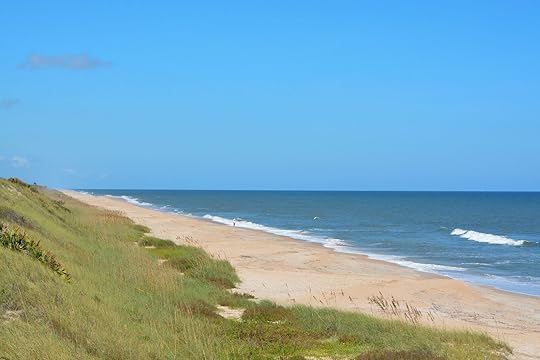
Photo: Norm Lane/Shutterstock
Peek over the tall, grassy dunes that line A1A just south of Ponte Vedra, and you’ll find yourself on a stretch of golden sand that’s unlike any other beach in Florida. Guana River Preserve, with its light tan shoreline and towering plant-covered dunes, looks more like the coast of Zanzibar or some other far-flung beach. It’s rarely crowded with much more than people looking for shark teeth, adding to the isolated allure. The beach has an interesting history too: According to a statue in the parking lot, this beach is roughly where Ponce de Leon first spotted Florida, and though that claim may be dubious at best, it’s still fun to picture his ships gliding off in the horizon.
On the Treasure Coast: Hutchinson Island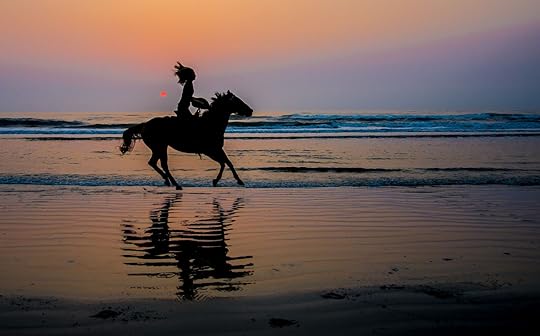
Photo: Sandi Cullifer/Shutterstock
The Treasure Coast isn’t lacking for fantastic beaches, as cities like Vero Beach and Stuart have thus far avoided becoming painfully crowded. But the region’s unspoiled spot is Hutchinson Island, a narrow spit stuck between Ft. Pierce and Pt. St. Lucie. It’s home to Frederick Douglass Memorial Park, one of the few spots in the state where you can ride horses on the beach, as well as into the ocean itself if the waves are cooperating. Riding along Hutchinson Island is a unique way to experience Florida’s beaches, and with waves to the east and forest to the west, galloping down the sand is a true natural escape.
Near Sarasota: Bradenton Beach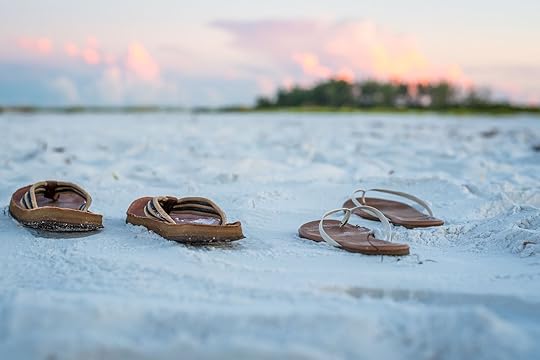
Photo: Joseph Thomas Photography/Shutterstock
The sunsets at Anna Maria Island are the stuff of Florida legend, and many long-time residents will call them out as the best in the state. With that acclaim, though, comes a shortage of stuff like parking and rental units during peak seasons. What few don’t mention is that just south of Ana Maria you’ll find the same glorious sunsets and silky smooth sand along Bradenton Beach, which gets far less attention. Sunny lunches of fresh seafood and cold beers at the Beach House are pure vacation fantasy, and once you’re done it’s a short walk to either Cortez or Coquina Beach. The latter sits just across the street from Leff Key Preserve, where 1,500 feet of boardwalk take you through majestic mangroves, and a small “hill” (by Florida standards) that offers elevated views of the Gulf of Mexico and Sarasota Bay.
Near Jacksonville: Atlantic Beach
Photo: lunamarina/Shutterstock
People in Jacksonville are especially fond of letting the city be the far-off fourth city in Florida, because they know they’ve got it pretty good and don’t want the rest of the state in on the secret. You’ll have this epiphany while strolling Atlantic Beach, a wide swath of sand north of Jax Beach with a strong SoCal vibe. That’s not just because the waves here are some of the most surfable in Florida, but also because the intimate downtown is filled with yoga studios, gourmet coffee shops, and organic food restaurants. Waking up early and experiencing an Atlantic Beach sunrise is somehow more tranquil than any other beach in the state, whether it’s because the breezes are just a little cooler, or because the people around you are too.
Near Miami: Crandon Park Beach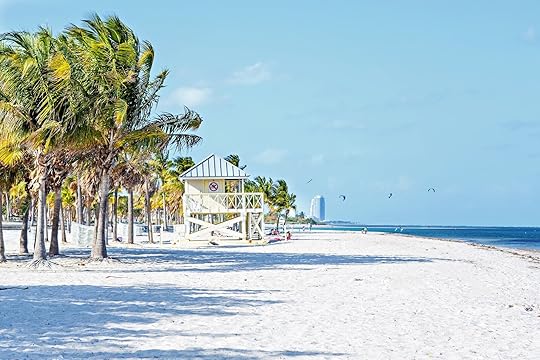
Photo: Irina Wilhauk/Shutterstock
In Miami, the temptation for beach goers will always be ballyhooed South Beach. And nature-loving locals may opt for Bill Baggs State Park at the end of Key Biscayne. But sandwiched in between is Crandon Park, a postcard-perfect county beach a few miles north of Bill Baggs. Crandon has the softest sand of any beach in South Florida, paired with inviting shallow aquamarine waters ideal for swimming, snorkeling, or just trying to cool off. Certain stretches offer views of endless ocean, giving the urban park a desert island vibe. It’s also lined with barbecue shelters and volleyball nets, so if you’re planning a big family trip to Miami you can have a beach barbecue day fairly easily.
Near Melbourne: Archie Carr National Wildlife Refuge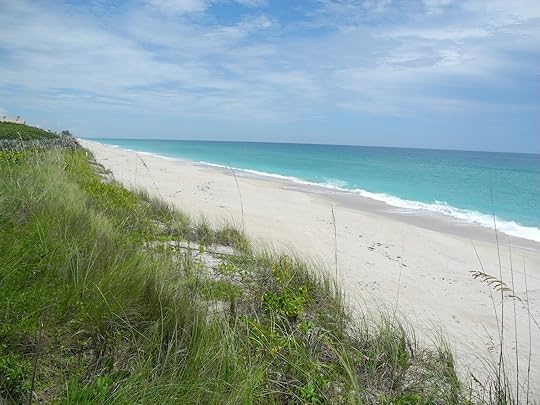
Photo: Jose Antonio Perez/Shutterstock
Aside from Cocoa Beach, the beaches of the Space Coast are largely some of the more under-appreciated in Florida, as cities like Titusville and Melbourne aren’t decked out in highrise condos like much of the state. You’ll find this mostly-undeveloped wildlife refuge about 20 minutes from downtown Melbourne. It’s one of the largest nesting areas for green turtles in the world. Not that the beach is teeming with turtles, but if you go during the summer you can join a nighttime turtle walk to observe them nesting. Even during the day, this sparsely populated beach is a pristine slice of natural Florida where the hardwood hammock habitat across the street makes for a cool, shady nature walk after an afternoon in the sun. As you stroll, you’ll learn how its rehabilitation has been one of the state’s great conservation success stories.
On the Florida Keys: Sombrero Beach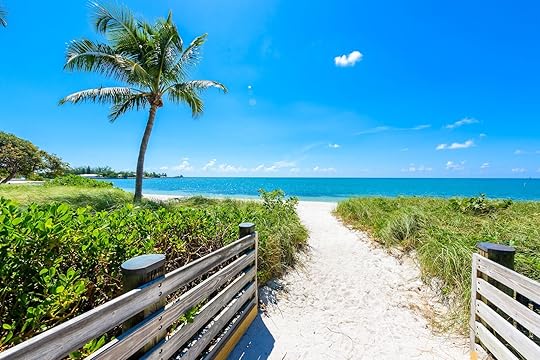
Photo: Simon Dannhauer/Shutterstock
The Florida Keys are much like Hawaii in that the moment you arrive you feel instantly relaxed. They are not like Hawaii, however, in that there aren’t many beaches from which to enjoy said relaxation. Of the few, Sombrero Beach might be the one flying lowest under the radar, a crescent-shaped slice of paradise along the Straits of Florida. The beach isn’t far off the Overseas Highway in Marathon, but somehow it’s overlooked by travelers headed to Key Largo and Key West, so aside from a smattering of families you’ll rarely find it crowded. What you will find, however, is a perfect place to post up with a lawn chair, a cold beer, and some Jimmy Buffet on the stereo.
Near Ft. Lauderdale: Pompano Beach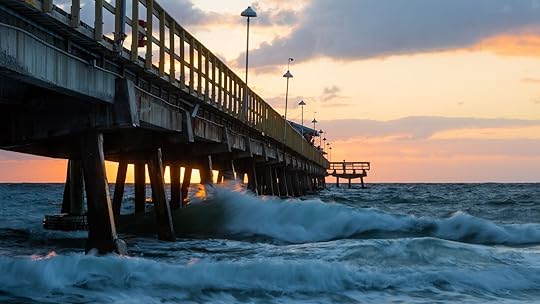
Photo: ulrich missbach/Shutterstock
One would think the widest, grandest beach in Florida’s most populous region would be known for a little more than harness racing and Rick “The Model” Martel. Yet somehow, the absolutely enormous beach in Pompano hiding somewhere between Palm Beach and Ft. Lauderdale often gets forgotten. All the better, as an afternoon here means never having to look for space to set up your towel, and also often means finishing up with drinks at the swanky Beach House or Seaside Tiki Bar. Pompano’s draw is more than just its size. Just offshore, divers can tour 17 wrecks in the city’s’ Shipwreck Park. Those wishing to stay above the waterline can also get a workout on the beach’s seaside circuit training machines. 
Advice to allies before Pride month

Every summer, cities around the world fill with rainbows for Pride month. Pride flags are unfurled, sometimes spanning entire blocks, and costumed paraders take to the streets in support of the LGBTQ+ community. In cities like San Francisco and New York City, Pride has become a can’t-miss event for both those who identify as LGBTQ+ and those who identify as allies.
For straight and cisgender attendees, however, it’s important to remember that Pride is more than just a party. Keep these six things in mind to ensure that lending your support and enjoying the festivities doesn’t translate to exploiting the LGBTQ+ community.
1. The first Pride was a police riotPride occurs each summer to commemorate the Stonewall Riots that happened in New York City in 1969.
At the time, most states had laws in place banning LGBTQ+ people from assembling in groups. The mob opened bars where people could gather in order to profit off the discrimination of our community. The venues were the only “safe” spaces for LGBTQ+ people but they were frequently raided by the police. Tired of harassment, patrons of The Stonewall protested, which turned into several days of riots. At its peak, over 1,000 people took to the streets of Greenwich Village in one of the first organized modern LGBTQ+ protests.
So, although you’ll see sequins, rainbows, parade floats, and pool parties sponsored by liquor brands and banks, understand that Pride is equal parts celebration, protest, and community-building.
Because our bodies and our identities are still policed by the government, religious groups, and even the people we love, we reserve Pride as the opportunity to express ourselves authentically. Sometimes that’s by drunkenly singing Robyn songs at the top of our lungs, and sometimes it’s by crying during the eulogy for our murdered trans sisters.
2. A lesbian bar during Pride is not the place to look for your unicornAs a femme-presenting queer woman, I’ve been hit on by cisgender men and straight couples in queer settings more times than I can count. Some queer women are attracted to men, some aren’t. We go to LGBTQ+ spaces to be around other LGBTQ+ people and celebrate our identity. Sure, there may be people who are interested in your advances, but there will also be people who will take offense. Pride should first and foremost be a safe space for LGBTQ+ people. Keep this in mind and don’t treat Pride like a venue for arranging a ménage à trois.
3. Don’t take pictures of us without permissionYou’re going to see folks in leather, drag performers, transgender people, non-binary people, nakedness, gender-bending getups, and some wild outfits. We’re not here to be a spectacle to you. We’re here to celebrate with folks who are like us. Don’t post photos of us on social media to be edgy or to show your superior open-mindedness. We don’t exist for your amusement.
4. If your thought process is “Gays are okay, but I don’t get the whole trans thing”Don’t come to Pride.
5. Pride is not the appropriate venue for your girl’s night or your bachelorette partyLots of straight women have told me they love going to gay bars because they can dance and celebrate without the presence of come-ons from men. I’ve seen drunken sorority girls climb on stage and attempt to make the show about them. I’ve seen women get a bit too intoxicated and attempt to make out with or grope gay men. LGBTQ+ spaces should, by definition, be safe spaces for LGBTQ+ people. If you attend Pride as a straight ally, remember what, and who, the event is about and lend your support appropriately.
6. You’re a guest in our space. Act accordingly.The important takeaway here is not that LGBTQ+ people hate straight or cis folks. It’s not even about straight and cis folks at Pride. It’s about when straight and cis folks behave in inappropriate and culturally insensitive ways that threaten or dampen the experiences of LGBTQ+ people at events that are made for us. Straight and cis folks can go to any party and feel comfortable dancing, holding hands, and making out with their significant other, or even a stranger, without feeling like they could be in danger because of their identity. LGBTQ+ folx do not always have that luxury. 
June 7, 2022
You Can Rent Shaggy’s Mystery Machine Van From Scooby-Doo on Airbnb
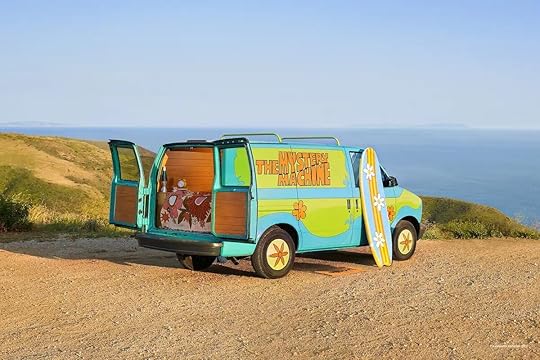
Admit it — you’ve always wanted to travel around in Shaggy’s Mystery Machine from Scooby-Doo. Now, Airbnb is giving you the chance. The company has partnered with Matthew Lillard, who played Shaggy in the live-action film to rent the actual van used in the production. The Scooby-Doo Airbnb is parked in southern California, a stone’s throw from the beach. What’s more, rentals cost only $20 per night — a nod to the film’s 20th anniversary.
We hope you love the Scooby-Doo Airbnb we recommend! Just so you know, Matador may collect a small commission from the links on this page if you decide to book a stay. Listed prices are accurate as of the time of publication.

Photo: Airbnb
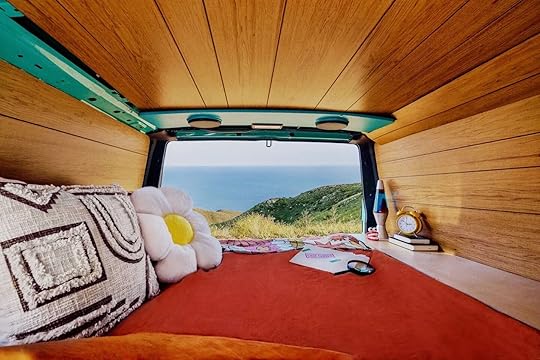
Photo: Airbnb

Photo: Airbnb

Photo: Airbnb
The catch is that you must act fast. Bookings open on June 16, and only three stays are available — on June 24, 25, and 26. That said, each is quite the deal — for $20 you get to stay in the van, decked out with lava lamps and a sound system bumping summer tunes. You’ll be greeted by Lillard upon arrival, and you’ll dine at an all-you-can-eat buffet featuring Shaggy and Scooby’s favorite treats.
“I’ve been channeling Shaggy since the live-action adaptation in 2002, and he’s been a part of me ever since,” said Lillard. “I can’t wait to welcome guests into the world of the Mystery Inc. gang as their Airbnb Host and give them a summer vacation they’ll never forget…monsters not included!”
Guests will also be treated to a late-night rewatch of the film and get to play mystery games to challenge their own problem-solving skills. And there’s no reason to cram inside the van for the duration of your stay — outside the van will be a lounge setup worthy of Scooby’s finest days.
To reserve your spot in the Mystery Machine, bookmark this page or follow the button below. On June 16, log on at 1:00 PM EST and enter for your chance to book the stay.
Even if you don’t land one of the stays in the Mystery Machine, Airbnb’s new Campers category offers 12,500 campers available around the globe, meaning you can still live the van life this summer, Shaggy style. 
Indonesia Plans To Offer Remote Work Visa That Lets You Stay in Bali for Up To Five Years

Indonesia is launching a new five-year visa for remote workers, according to a report from Bloomberg. As part of the country’s push to lure higher-spending, longer-staying travelers to its islands, government and tourism officials believe a Bali digital nomad visa that doesn’t require renewal every 30 or 60 days is key to bringing in expats.
The country hopes to highlight its eco-tourism options and, in the case of Bali, the spiritual and wellness scenes that have made the island a top draw for expats for the past decade. While beach-goers and partiers will always be attracted to the coastal towns of Canggu, Kuta, and others, it appears the government hopes to entice those who may prefer to stay in the jungle village of Ubud, instead.
“In the past, the three S was: sun, sea, and sand. We’re moving it to serenity, spirituality, and sustainability. This way we’re getting better quality and better impact to the local economy,” says Sandiaga Uno, Indonesia’s tourism minister to Bloomberg Television.
When available the visa will grant a stay for up to five years in Indonesia without paying taxes, so long as the user isn’t working for a national company or otherwise making income from a business within Indonesia. The new policy will follow other countries, including Aruba and Estonia that have launched digital nomad visas intended at luring remote workers with long-term stays and tax-free status.
Indonesia currently allows fully-vaccinated travelers to visit without testing or quarantine requirements. 
Dog Sledding, Ice Fishing, and Foraging: How To Experience Greenland’s Indigenous Hunting Traditions

The Greenland Ice Sheet covers over 80 percent of Greenland—the world’s biggest island— leaving its nearly 57,000-strong population to live in cities and villages along the coast. To get around between these small towns, you need to travel by helicopter and ferries, not cars, trains, or buses. Meaning that a trip to Greenland takes a lot of careful planning. Even to the first-time visitor, it quickly becomes clear that for every aspect of life in Greenland, the weather dictates where and when you can go anywhere. But a trip to Greenland is well worth the effort, if only to take part in the many indigenous hunting and fishing experiences this Arctic island offers visitors.
The people who know the most about Greenland’s finicky climate are probably the country’s indigenous Inuit population. Descendants of the Thule people that migrated to Greenland in the 9th century, their culture, customs, cuisine, and livelihoods have been molded by the challenges of the Arctic climate and an otherworldly landscape of mountains, fjords, icebergs, sea ice, and glaciers. Here hunting, gathering, and fishing are more than just a means of survival—central to the Greenlandic identity. These traditions are also about pride, tradition, and heritage — and there indigenous hunting and fishing experiences many communities are willing to share with tourists.
Hunters and fishermen rely on dog sledding as a means of transportation to cross long distances in winter. While in modern times, snowmobiles are an efficient alternative, dog sledding is still necessary to reach parts of the back country that snowmobiles cannot, and to keep environmental impact to a minimum. The income from tourism helps the mushers feed their dogs and keep the traditions like dog sledding alive.
Luckily for tourists, indigenous hunting and fishing experiences are within reach if you’re interested in learning about the Greenlandic way of life. Here are all the indigenous hunting and fishing experiences you can book in Greenland.
What to eat in Nuuk, Greenland’s capital
Photo: Natasha Amar
Spend a day or two exploring the capital Nuuk, home to nearly 15,000 people. With museums, restaurants, and contemporary architecture, all over Nuuk, it’s an excellent place to dip your toes in the art and food scenes of Greenland.
A 30-minute walk from the city center, the cozy Cafe Inuk overlooks Nuuk Fjord and is a great spot to sample Greenlandic cuisine. One of the co-owners of the cafe and the surrounding group of colorful houses that together make up Inuk Hostels is Maren-Louise P. Kristensen. Inuk herself, she is both knowledgeable and passionate about the stories of Inuit cuisine.

Photo: Natasha Amar
If you’re after dishes that speak to the history and landscape of Greenland, expect to be served foods like ammassat or dried capelin, and panertoq (otherwise known as salted and dried cod) — both are commonly eaten snacks in Greenland. Then there’s mattak, or raw narwhal blubber, cut into small pieces that you can dip into soy sauce. Raw, smoked, or dried, salted and preserved, these foods reference a cuisine that was shaped by the cold, harsh environment of the Arctic.

Photo: Natasha Amar
You’ll find some of these on the menu at Cafe Inuk, as well as more modern dishes like a reindeer burger and a flavorful reindeer stew.
How to go fishing in Nuuk Fjord
Photo: Elia Locardi, Visit Greenland
Between June and September, take a cue from the locals and hop onboard a bright yellow Nuuk Water Taxi from the old harbor of Nuuk to set sail in the Nuuk Fjord for some deep-sea fishing. On this 6-hour day trip, you’ll have plenty of time to admire views of Sermitsiaq Mountain as well as islets, waterfalls, and icebergs. Thanks to the abundance of cod and redfish in these frigid waters, even the most inexperienced anglers can expect to find themselves in luck.
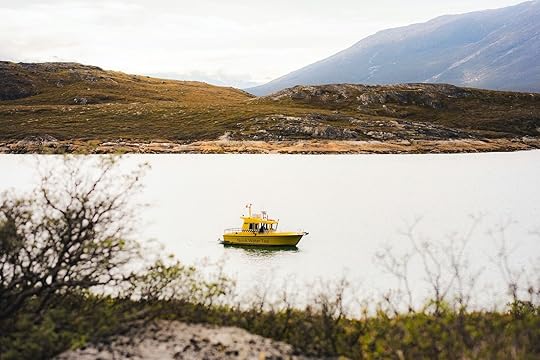
Photo: Aningaaq R Carlsen, Visit Greenland
Catch in tow, you’ll arrive at the settlement of Qooqqut, about 30 miles from Nuuk, to dine at Qooqqut Nuan, a restaurant housed in the restored building of a former sheep breeding station, that was also once a burned-down hotel. Surrounded by mountains in a landscape with rich geological history, the restaurant is owned by Inuk chef Mads Bek who also grows vegetables and herbs such as Arctic thyme.
Serving fresh seafood dishes that marry Danish, Greenlandic, and Thai influences, thanks to Bek’s wife, who is from Thailand, this place is very popular in the summer. Do as the locals do and hand over your freshly-caught fish to be turned into one of the best meals you’ll have in Greenland. Then, enjoy the feast alongside sublime views of the fjord before returning to Nuuk.
How to go ice-fishing in Uummannaq
Photo: Erez Marom – Visit Greenland
Located in northwestern Greenland, above the Arctic Circle, the town of Uummannaq is named after the heart-shaped mountain that rises over it. Here, colorful houses dot the rocky island that is home to just 1,400 people.

Photo: Trevor Traynor, Visit Greenland
In winter, between February and April, with the town as your base, you can go ice-fishing with Uummannaq Sea Safaris. Surrounded by the magnificent frozen landscape of the Uummannaq Fjord, you’ll follow the example of Inuit fishermen and journey from town by snowmobile to a fishing spot, where you’ll use a tooq, or a long wooden ice chipping tool, to make a hole in the sea ice.
Then you’ll learn how to use a hook attached to a sinker and a line that is nearly 500 meters long to catch catfish, redfish, or Greenland halibut. Even in freezing temperatures, expect to sweat under your layers while hauling your catch. While this 5-hour tour sounds like hard work (and it is), it’s also one of the more exciting cultural experiences you can have in the country.
How to go dog sledding in Ilulissat
Photo: Natasha Amar
From December to April, you can experience the magic of traversing the country’s surreal winter landscapes by dogsled in Ilulissat, a town of 4413 people, that lies 217 miles north of the Arctic Circle on the country’s west coast.
On a dog sledding tour with World of Greenland, you’ll be picked up from Ilulissat. You’ll change into warm sealskin clothing, then, seated in a wooden sled harnessed to a pack of dogs, you’ll find yourself crossing sea ice, glacial streams, and frozen fjords. Bred specifically for dog sledding (not pets, as you’ll be informed), their immense strength and intuitive ability to judge the thickness of sea ice make them an indispensable part of life in the Arctic.
Leading them is an Inuit musher whose commands, along with the sound of his cracking whip, are the only sounds in an otherwise quiet landscape. Halfway, you’ll take a break to sip on hot coffee and take photos while the dogs rest before the journey back to Ilulissat.
How to stay at a reindeer farmFor a true taste of Greenland’s hunting and fishing lifestyle, book a tour with Wild Greenland, an operator located at Isortoq Reindeer Station, a working reindeer farm in South Greenland between July and September. To get here, fly to Narsarsuaq, a village of just 169 residents, before sailing to the reindeer farm where you’ll be based for a week.
Over the next few days, find yourself completely immersed in the self-sustaining way of life at the farm. Go on scenic hikes to see lakes, valleys, and rivers and incredible views of the Greenland Ice Sheet. Spot musk oxen, free-roaming reindeer, Arctic hares, Arctic foxes, sheep, and eagles, and learn how to forage for berries, herbs, and Arctic tea.
Go on sailing trips in the fjord system to see calving glaciers and hike on a glacier.
Try your hand at deep-sea fishing, fish for Arctic char in rivers, and learn how to smoke fish for dinner. This tour offers plenty of insight into life as a reindeer farmer with opportunities to learn skills like knife carving, tanning skins, and food preservation.
You’ll sleep in simple but comfortable rooms at the farm and spend a night in a tent at an old Inuit camp by the sea. The meals here are prepared from locally foraged and grown ingredients, fish that has been caught that day, and reindeer from the farm. 
Matador Network's Blog
- Matador Network's profile
- 6 followers



